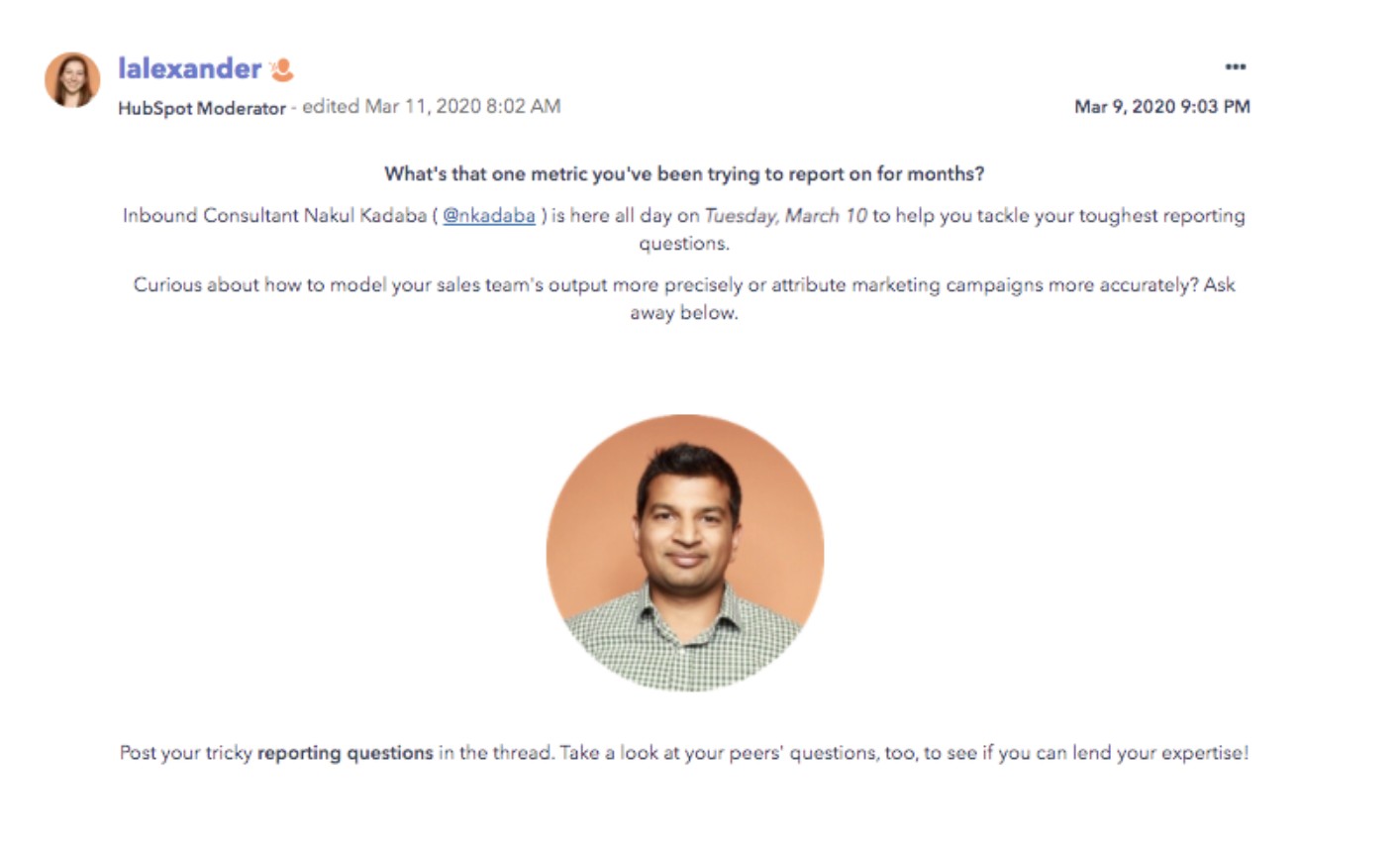This post is a part of Made @ HubSpot, an internal thought series through which we extract lessons from experiments conducted by our very own HubSpotters.
Consistent content creation is a cornerstone of community growth. To keep your community members returning regularly, they need to see new things each time they return.
Think about social media: the platforms remain addictive because you can refresh your feed and see new material any time you visit.
Different types of people want to engage in communities in different ways.
Some seek out one-to-one connections with like-minded people whom they can call on for advice or input. Others prefer to participate in large discussions and collect a variety of perspectives. Some love giving feedback because they’re invested in making your product or service better.
And, inevitably, there are lurkers: people who don’t like to engage actively at all, but who read and watch content to expand their knowledge.
Long story short, there should always be a variety of opportunities for engagement available. But community management typically falls on one person’s shoulders.
How can you feasibly create enough content to get your community members returning regularly when daily community management and moderation tasks could justify a full-time role themselves?
Here at HubSpot, one way we’ve scaled our community content creation is by leveraging internal teams’ expertise and time to provide value to the community members.
Getting buy-in from those teams is often a lighter lift than you’d imagine when you ensure there is something in it for them.
Here are eight ways you can leverage your internal employees’ time and expertise to generate varied, interesting content and engagement opportunities for your community.
Discover the best forum software for creating an online community for your business.
1. Text-Based AMAs with Your Product Team
Host an “ask me anything” (AMA) session with a member of your product team over a text thread. Alert your community a week in advance and allow them to submit questions about your product on that thread. On a specific day, have your AMA hosts come in to answer the questions.
Community members can ask about the product itself, where it’s headed in the future, and how the team developed it to the point where it is today. If you have multiple products or product lines, consider running specific AMAs for each one.
You may need to experiment to find the right scope — one where there will be enough questions to have a good discussion, but not so many that it becomes unmanageable to respond in a timely manner.
These are great opportunities to make your customers feel like they’re part of your company’s journey. Here at HubSpot, we’ve found that giving customers a look at what we’re building shows customers that we’re constantly considering their feedback and working to create a better product for them.
AMAs also gives your product team insight into what confuses your customers and what they’re most excited for. Your customers can also reveal product use cases you weren’t aware of.
Be sure to have the host tag in the users who asked the questions if your community platform doesn’t automatically send them a notification letting them know that someone has replied.
2. AMAs with Your Leadership Team
Run an AMA featuring one of your executives. Your customers will be delighted that the people at the top want to take the time to chat with them. Providing them access to an executive is particularly special because executives tend to be short on time.
Because executives have such packed schedules. when you pitch them, make sure to show them what’s in it for them: the chance to interface with many customers at once and get an unbiased pulse check on how your customer base thinks about a given topic, your company, or your product.
A text thread is a perfect format for executives because they can answer questions in the small pockets that come up between meetings — there isn’t pressure to carve out a large block of time within the day.
Consider pairing the executives with folks on your team as behind-the-scenes backups to help find the answers to questions, draft replies, or polish written answers before posting to lighten the load on the official host.
3. Strategic AMAs
You almost certainly have subject matter experts at your company, and those experts are often looking to build their personal brand. By providing thoughtful and honest responses to your community’s questions, they can build credibility as a thought leader in your space.

For example, we hosted a community AMA with an in-house expert on brand building who was looking to build his LinkedIn following. He enjoyed the process of answering the questions, crafted thoughtful responses that customers appreciated, and gained LinkedIn followers along the way.
4. Live AMA Sessions
Host any of the types of AMAs mentioned above in a webinar or virtual meeting format. Allow customers to submit questions on a thread or in a survey ahead of time and register to watch the host answer them on a certain date.
Provide your host those questions a day or more in advance to allow them time to prepare, and then interview them live on the specified day.
If it’s a small audience, host it over a virtual meeting software. If it’s larger, host with webinar software that allows attendees to submit questions through a chat pane.
The content produced can live on longer than the live session, too. Post written key takeaways one day and the recording the next. You can also repurpose sections of the recording for social media or blog content. If the host is an executive or subject matter expert, provide them with the key takeaways to post on their personal blog or LinkedIn.
5. Feedback Surveys
If your customers are taking the time to visit your community, they’re probably invested in your product and its future. Members of the HubSpot Community have provided thoughtful and thorough feedback through product feedback surveys. Experiment with asking for feedback in different formats, with different lengths of surveys, and on a variety of products.
We’ve found at HubSpot that community visitors also love engaging with simple, one-question polls. Pin the poll to the top of the community or, if your platform allows, float it in the bottom corner of the site.
Since the product feedback will directly benefit the team creating those products, ask them to create the survey or poll and spend your time tweaking the language to be community friendly and user-focused.
Don’t be afraid to push back if you think the survey is too long, not appropriate for your member audience, or not user-centric.
6. Virtual Coffee Chats
Some people will always prefer speaking with others to typing out their thoughts. Organize a virtual coffee chat on a particular topic that binds community members together to give those people the opportunity to spend time with each other.
To get started, put together a few icebreaker questions and collect additional questions that your customers have for one another through the registration process.
Equip a community manager or customer success team member with those questions and a set of best practices for facilitating conversation and give them license to run a 45- to 60-minute discussion.
You can post the recording in the community later and pass it along to any members of your customer success team or product team who might benefit from hearing how customers think about your product or what’s on their minds.
7. Adapted Support Tickets
Has your team been seeing an issue pop up again and again in customer support tickets that can’t fully be addressed by a knowledge base article? Anonymize and edit the content of existing support tickets on that issue.
If a couple of your customers mentioned it in support tickets, many more probably share the same question.
Ask your support team to send over several tickets that represent the hottest issues popping up. Make sure to edit out any details that would compromise your customers’ privacy if shared publicly, and then post the ticket itself as a question or the answer as a hack to share with the community.
8. Product Clinics
Most applicable for technology companies, product clinics are structured like AMAs but are less focused on the host and more on solving product issues.
What’s a particularly confusing or troublesome part of your product? Maybe you’ve identified that area from support volume, anecdotes from your customer success team, or poor reviews.
Host a product expert in your community and hold a skill-building or troubleshooting Q&A in that area. Promote the thread in advance and have the expert pop in every few hours over the course of a day or two to answer questions.

You’ll show your customers you care, surface more insight into what’s really confusing your customers, and help them overcome their roadblocks in a public forum that can help other users later.
Over to You
If you’re inspired by any of these ideas, remember: you should have a baseline understanding of who your community members are before you seek out team members who will partner with you to create content.
You don’t want to ask for your team’s time only to have it provide little value to both your community and your colleague.
At the same time, keep in mind that not everything you think will be a hit will end up resonating, and there are plenty of ideas you may not be considering right now that actually would succeed.
Plan a variety of content out for the future, including some experimental topics, and then pay close attention to what performs well, iterating to grow engagement and find the right cadence for each content topic as your community matures.

